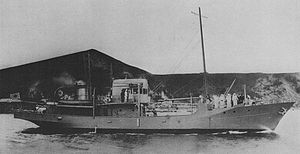- No.1 class auxiliary minelayer
-

Aux. Minelayer No.1 on 28 February 1942Class overview Name: No.1 class auxiliary minelayer Builders: Uraga Dock Company Operators:  Imperial Japanese Navy
Imperial Japanese NavyPreceded by: Sokuten-class Built: 1941–1942 In commission: 1942–1947 (?) Planned: 4 Completed: 4 Lost: 3 Retired: 1 General characteristics Type: Minelayer Displacement: 215 long tons (218 t) standard Length: 35.11 m (115 ft 2 in) overall Beam: 6.16 m (20 ft 3 in) Draught: 2.38 m (7 ft 10 in) Propulsion: 1 × low-speed diesel
single shaft, 400 bhpSpeed: 9.5 knots (10.9 mph; 17.6 km/h) Range: 1,500 nmi (2,800 km) at 9.5 kn (10.9 mph; 17.6 km/h) Complement: 63 Armament: • 1 × 76.2 mm (3.00 in) L/40 AA gun
• 2 × 13 mm AA guns
• 40 × Type 93 naval mines or 16 × depth chargesThe No.1 class auxiliary minelayer (第一号型敷設特務艇, Dai Ichi Gō-gata Fusetsu-Tokumutei) was a class of minelayers of the Imperial Japanese Navy (IJN), serving during World War II. They were built to supplement timeworn the Sokuten-class. 4 vessels were built in 1941–42 under the Maru Rin Programme (Ship # 257–260).
Contents
Background
- In 1939, the Sokuten-class was the main minelayer of the local guard districts. However, they were too old. The IJN wanted new small minelayers for local guard districts.
- In 1940, the IJN found out a handy boat. It was a standard longline fishing ship Sōyō Maru (160 tons) by the Ministry of Agriculture, Forestry. The IJN made a model of it and completed a design of new small minelayer. Uraga Dock Company built all of the vessels.
Ships in class
Ship # Ship Laid down Launched Completed Fate 257 Medan on 27 March 1945. Decommissioned on 3 May 1947. 258 Surabaya on 31 December 1942. Decommissioned on 20 March 1943. 259 Car Nicobar on 20 November 1944. Decommissioned on 3 May 1947. Photos
Notes
Bibliography
- Ships of the World special issue Vol.45, Escort Vessels of the Imperial Japanese Navy, "Kaijinsha". http://www.ships-net.co.jp/., (Japan), February 1996
- The Maru Special, Japanese Naval Vessels No.47, Japanese naval mine warfare crafts, "Ushio Shobō". http://www.kojinsha.co.jp/. (Japan), January 1981
Japanese auxiliary ship classes of World War IICargo ships Colliers and Oilers Ōtomari S
Landing ships No.1 · No.101 · Shinshū Maru S (Army) · SS (Army)
Minelayers and Cable layer Tokiwa SC · Itsukushima S · Yaeyama S · Okinoshima S · Tsugaru S · Minoo SC · Shirataka S · Hatsutaka · Tsubame · Natsushima (1933) · Sokuten (1938) · Hirashima · Ajiro S · Kamishima · Hashima · Sokuten (1913) · Aux. No.1 · Aux. No.101 (ex-HMS Barlight) SC
Minesweepers No.1 (1923) · No.5 (1928) · No.13 · No.17 · No.7 (1938) · No.19 · No.101 (ex-HMS Taitam and Waglan) C · Aux. No.1 · Aux. No.101 (ex-HNLMS DEFG class) · Aux. No.104 (ex-HNLMS DEFG class)
Patrol boats Seaplane tenders Submarine chasers
Survey ships Target ships Training ships Fuji SC · Shikishima SC · Asama SC · Azuma SC · Kasuga SC
S - Single ship of class • C - Converted to ship type • I - Incomplete until the end of war Categories:- World War II naval ships of Japan
- World War II minelayers of Japan
- 1940s ships
Wikimedia Foundation. 2010.



